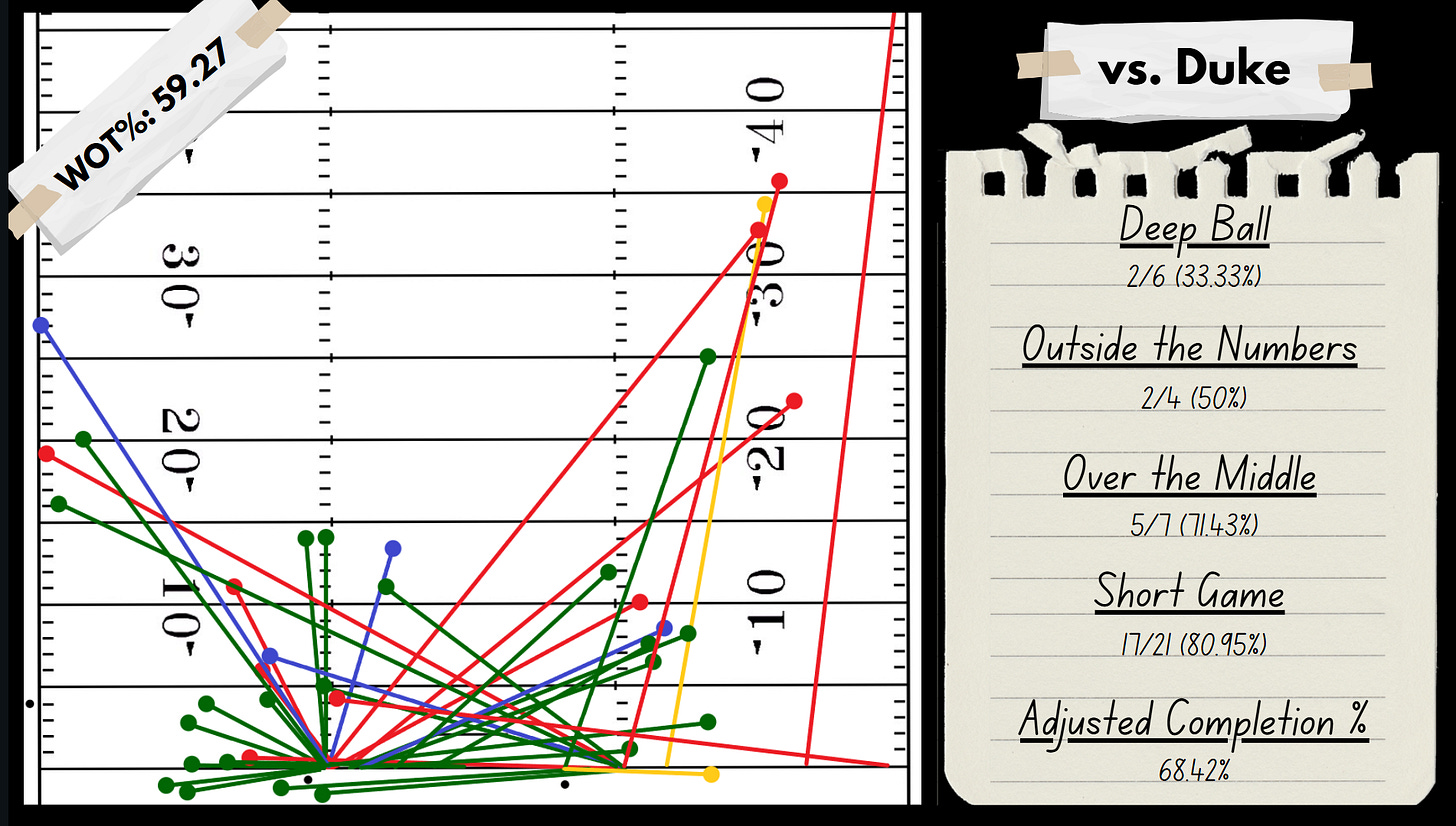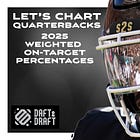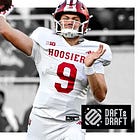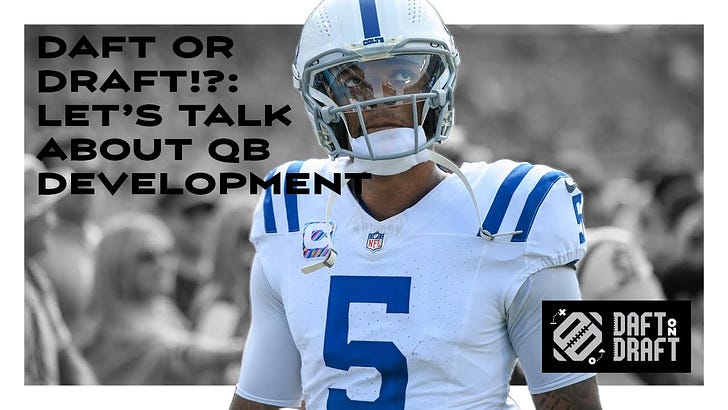Film Room: Does the tape match the box score for Cam Ward?
Despite the sexy box scores, Miami quarterback Cam Ward has been showing significant cracks in his game with his 2025 NFL Draft stock on the line
Miami Football quarterback Cam Ward has been one of the hottest names in the 2025 NFL Draft class this year, but all of the hype is a bit over the top.
Ward is currently fast-tracking himself to New York as a finalist for the Heisman Trophy. He is leading the Hurricanes on an undefeated run, sitting at 9-0 on the season, and one would think he is the best player in the draft by a wide margin looking at his box score.
After transferring over from Washington State this offseason, Ward has amassed over 3,100 yards passing, 29 touchdowns (both are the most in the nation), and six interceptions through those nine games. However, when getting out of the box score and away from the social media dopamine bytes and looking under the hood of his tape, there are potentially damning cracks in his game.
While Ward started the season flawlessly, there have been more and more dents popping up on his draft profile since entering conference play. Using the Duke tape, we will take a look at some issues with Ward’s 2025 NFL Draft profile that have been showing through since the Hurricanes entered ACC play.
So let’s have a discussion on the Heisman hopeful and why there are reasons to be hesitant about his prospects at the next level.
Let’s start with the positives
Next, There is no doubting the physical uncoachables that Ward possesses. They are undeniable and the primary reason why Ward is being talked about as a potential top-ten pick in the 2025 NFL Draft.
The ball explodes out of Ward’s hand and his arm is the most flexible in the class. He can throw over the top, drop it down to three-quarters, and even manipulate windows to throw sidearm as well. This is a massive appeal to NFL teams.
His lower half is near the top of the class as well. Ward can extend just about any play and escape just about any pocket (this will come up later in the article as well). At a listed 223 pounds as well, Ward is a load to try to bring down when defenders get him wrapped up.
This was the case against Virginia Tech where it looked like Ward was sacked at a crucial point in the ballgame but was able to keep his footing and shovel the football out to his back for a massive gain.
After the Kansas City Chiefs and Buffalo Bills swung big on physical tools looking to coach up the rest, the NFL as a whole started chasing gunslingers with big arms and the ability to extend plays. However, that burned a ton of teams and the pendulum has swung back since as players who carry the cerebral part of the game at a higher level have taken over.
Joe Burrow and C.J. Stroud represent this new (old) wave of quarterbacks. Of course, the 2024 class represents a bit of both. All of Caleb Williams, Drake Maye, and Jayden Daniels possess tantalizing tools but proved to do the little things well on the mental side of the game too.
But does Ward fall into that category or does he fall into the tool-hunting one? I tend to think it’s the latter.
Down the field accuracy woes
Ward has proven to be extremely effective down the hashes and over the middle, specifically when he can sit ahead of schedule and rip RPOs through the heart of the defense. However, when Ward is asked to push the ball down the field and outside the numbers, his general accuracy takes a steep hit.
He’ll throw a beautiful ball along the boundary that will get clipped and posted to social media some will use it to negate this point, but the bigger, full-season picture is not quite as charming. Especially over the last two weeks, but largely since the Hurricanes entered ACC play.
Over his last two games against Florida State and Duke, Ward has been on-target on just 2-of-8 shots down the field. When looking at the full-season numbers when Ward has fired the ball deep down the field, the Miami quarterback sits with an on-target percentage of just 42 percent (14-of-33), and just 8-of-20 in ACC play.
Not only did Ward struggle again down the field against Duke, but he was also flat-out missing on throws he’s typically able to connect on.
The majority of Ward’s big plays are coming on schemed-open tendency breakers on screen-and-gos, heavy play-action on second or third and short where a leaking receiver gets free, or on RPO looks. The windows Ward is throwing to in these cases are massive.
Even on screens, he has been making his receivers reach outside of their frame, placing the football on the wrong shoulder. This completely kills any built-up momentum upfield before the catch.

On the season, his Weighted On-Target Percentage sits below 60 percent, with right around 64 being the historical threshold for quarterbacks who have been drafted high in previous years.
Red flag No. 1.
Improved, but still questionable, decision-making
Let’s start by acknowledging that Ward has made strides in working through progressions and getting his eyes to his backside reads in structure. Here are a plethora of examples of this from his game against Duke:
An issue, however, is that every last one of these reps is coming against either three-man or four-man looks. Even when kept clean, there are still times when Ward is bailing on fine pockets instead of stepping up, taking risky shots, and more.
Then there are instances of situational football. Like a third-and-three early in the game. Miami is running a spot concept. They just need three yards. Duke is playing Cover-2 to the play-side and the cornerback eats the flat. However, the stick and the flag over the top then are left to be matched.
The stick (again on third-and three!) was there if Ward leverages the ball into green grass. There is even an opportunity to throw the flag route open as well as the safety is playing off coverage, although certainly expecting the combination based on what has unfolded in front of him.
Instead, Ward attempts to make a play with his legs, flips the field to the opposite boundary, and sails a deep ball out of bounds where his receiver does not even have a chance to make a play on the football and the Hurricanes punted.
He was getting away with it early in the season against less-than-stellar competition, but the harm has been evident since entering ACC play.
Since conference play started, Ward’s pressure-to-sack percentage has shot through the roof, his turnover-worthy plays percentage has seen an uptick, and his time to throw has jumped up as well.
Since entering conference play, Ward has seen his pressure-to-sack rate shoot up to 20.9 percent. It sat at 9.3 percent over his first four games outside of conference play. His Time to Throw has jumped from 2.76 seconds on average to 3.03 seconds on average. This is the sixth-highest in the entire nation. His percentage of Turnover-Worthy Plays has jumped 1.5 percent as well from 2.1 percent to 3.6 percent.
This is all particularly accelerated and concerning when Ward has been faced with pressure.
Since ACC play started for Ward in Week 5, only LSU’s Garrett Nussmeier has had a higher turnover-worthy play rate when under pressure of 2025 NFL Draft quarterbacks. When he is faced with pressure, Ward’s time to throw has skyrocketed to 4.42 seconds per play, the slowest in the nation. Since Week 5, Ward also has the highest pressure-to-sack rate when he is faced with the blitz than any of the other talked about 2025 NFL Draft prospects at 20.5 percent (minimum of 50 dropbacks via PFF).
In the first half against Duke, Ward was faced with delayed pressure he was not shown pre-snap. He does a great job of stepping back into a clean window of the pocket, but instead of keeping his eyes up and firing the dig over the middle of the field after the linebacker jumped a hold route, Ward immediately panicked and looked to improvise.
There are real yards and progress left on the field while empty calories in the form of RPO hitters and screens are doing the heavy lifting in Ward’s box score. This was the entire second half for Ward. Miami peeled the playbook back and reduced the amount of decisions that the 2025 NFL Draft hopeful had to make after a rough first half.
The brainless interceptions have returned as a result, one against Cal and one this past weekend against Duke where Ward has completely abandoned structure on the run and thrown the ball all the way across his body and the field. These are interceptions that can be found all over his Washington State tape. They are a trend for Ward.
Even his touchdown throw to Xavier Restrepo off of a deflection was a ball that should have been an interception if the defensive back hadn’t played it incorrectly.
While Ward has curbed his fumbling issue, entering the season with 46 of them, he has put the ball back on the turf three times over his last five games since entering conference play.
If you speed Ward up, he tends to panic and make frantic choices with the football in his hands.
Red flag No. 2.
The main concern…
My main concern about Ward and his transition to the NFL is that all of the things that make him a fun and electric college quarterback are aspects of his game that NFL coaches will want him to tame down and potentially coach out of him.
NFL speed is different. NFL play speed is different. Ward predominantly opts to win outside of structure and along the boundaries on the field. This is where he wants to win. What has made Allen and Mahomes so effective is that they have learned to harness that madman play style and rip it out when it is necessary.
Both of those quarterbacks are great because they know how to win both pre-snap and post-snap, get their eyes where they need to get to quickly and get the ball out on time. Can Ward operate like this? And if he can, how long will the learning curve be for him to be an effective and trustworthy quarterback at the NFL level?
To me, this is the Zach Wilson situation.
Wilson was drafted second overall by the New York Jets, and much of it was due to the pomp and circumstance he put on tape outside of structure. Wilson would roll out, throw off-platform, and drop dimes into small windows deep down the field. His legs were an effective and flashy weapon as he led the BYU offense that year.
However, when Wilson operated in structure at BYU, he was often late, could not deal with post-snap rotations on the backend, and showed little signs of setting or understanding his own protections. The Jets and many analysts overlooked this aspect of his game and took a chance on the fun tools.
Wilson was then thrown straight into the fire without being given time to sit behind a veteran, learn, and adjust his game and to the speed at the NFL level.
We know how that worked out for him.
Red flag No. 3.
So now what?
The purpose of this article is not to say that Ward cannot be an effective starter at the NFL level. But it is to hammer home a larger point that Ward’s play style has proven to be extremely volatile at the NFL level and it may take him some time to learn to harness his top-tier tools into a controlled and tempered gunslinger.
However, Ward is being discussed as a potential top-ten pick, and if that is the case, what are the odds the Heisman hopeful will be given that time? He needs it. Especially if a team is investing that significant of capital to merge their two futures.
Ward went back to school after getting mid-round grades. Do we think he’s been that much better since transferring from Washington State to Miami? I see a lot of the same player. So why exactly are we seeing such a massive leap in his draft stock?
There is always an attempt to create a prospect in a weak class, to find a name, any name to throw around for quarterback-needy teams. That is the case this year as well. This isn’t to say that Ward doesn’t have love around the league; he certainly does. But in a class that is closer to 2013 and 2022 than it is any other class, that also may be out of supply and demand.
In both of those classes, NFL teams surprisingly showed restraint and only selected one quarterback in the first round. Despite the love right now in November, there is a chance we are headed to a potentially similar outcome here in what I think is a one-quarterback class (Sanders).
The tools are evident and enticing with Ward, but he needs much more time than he is going to be allotted at the NFL level before seeing the field given where he is currently getting projected in mock drafts.
We’ll see how this plays out over the coming months. He very well could end up as a top-ten pick. But that’s a steep bet on a player who needs what he would not be afforded in that case: time.
Daft or Draft!?: Talking Anthony Richardson and the NFL's horrid pattern of QB development
Cory and Dalton are back with another edition of Daft or Draft!?. In this episode, the guys talk about a few 2025 NFL Draft tight ends and safeties, but spend most of the time discussing the Colts, Anthony Richardson, and the NFL's horrid trend of developing young









